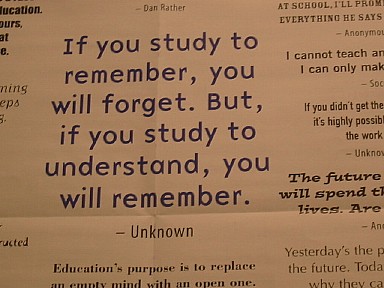|
FN 225: Nutrition
Rathakette, Ph.D. Health Professions Division Lane Community College Eugene, Oregon
LECTURE 1A
CORRECTIONS/ADDITIONS/HIGHLIGHTS: I find that viewing these lectures
works best with the following browsers: Safari if using a Mac
Explorer if using a Windows-based computer When I tried viewing the videos within the lecture on my PC using Safari, the videos would not download. When I used explorer the videos downloaded right away. Most of the clips you will be
watching for this class are of Beth
Naylor. She is a nutrition instructor who
has been teaching at lane for 35 years.
She developed this course so is seen in most of
the video clips. During Week 1, start to keep track of what you
eat. There
are
instructions under Week 1 of moodle on how to get
started with this. FORUM QUESTION:
NOTE: When you are in the FORUMS you will have the option to unsubscribe to the forums. If you do not do this, you will get copies of all the FORUM postings to your personal e-mail account. You will see the following in the left hand corner of your screen once you click on the FORUMS.  Make sure you've printed the lecture outline for chapter 1 from moodle before viewing this lecture. You will want to fill in the lecture outline while viewing the lectures for this week. You will use the lecture outlines to help answer study questions and to help prepare for exams. I suggest putting the lecture outlines in a 3-ring binder to create a "packet" or "workbook". You SHOULD NOT print this online
lecture! LECTURE 1A: Chapter1- Food Choices and
Human Health Begin by looking
at how this LECTURE OUTLINE is organized.
I'm hoping that these Lectures help you
understand the
material, not only to help you be successful on
tests, but also to
deepen your understanding so you'll remember it
even after the
course is over.
I The
Science of Nutrition
LECTURE
1B will continue
with Chapter 1.
II Placebo Effect III Identifying Valid Nutrition Info in the News: Scientific Research IV Identifying Nutrition Info that is unreliable (not valid) & that should make you suspicious V 4 Guidelines for Evaluating Nutrition Info on the Web (from the LCC library) I The Science of Nutrition A.
Definition
of a "Nutrient"-
a chemical
substance in food that
is required by the body to
provide energy, give the body structure and/or help it work. USING THE ABOVE
DEFINITION, which of
the following is a nutrient-
carrots,
vitamin A or both __________
Click here if you think the answer is carrots. Click here if you think the answer is vitamin A. Click here if you think the answer is both. The 6 categories (types) of nutrients for humans: 1.
carbohydrates (sugar, starch, fiber)
2. lipids (triglycerides, sterols, phospholipids) 3. proteins 4. water 5. vitamins 6. minerals Which of these categories do you think should be first? Click here if your
answer would be water.
Click here if your answer would be protein. Click here if your answer would be one of the other categories. The categories of nutrients that have energy that humans can use are (1) carbohydrates (starch and sugar but not fiber), (2) fats and (3) proteins. We call these the energy-yielding nutrients. B. MACRONUTRIENTS (not defined this way in our text): 1.
carbohydrates
(sugar, starch, fiber)
2. lipids (triglycerides, sterols, phospholipids) 3. protein 4. water Which of these macronutrients can be broken apart to yield energy for the human body? (see above) 1.
Vitamins.
Vitamins A, E, D, K and C are examples of vitamins. Also, there are 8 B-complex vitamins and they are thiamin, riboflavin, niacin, pantothenic acid, biotin, folate, B12 and B6. 2. Minerals. Examples of minerals include calcium, potassium, sodium and iron. Neither vitamins
nor minerals can be broken
apart to yield energy for the human body,
although vitamins DO have
energy. More about this later.
D. Is a potato a carbohydrate? _________Why or why not? Click here if you think
the answer is No.
Why is it NOT appropriate to call a potato a carbohydrate? You should now be able to answer this. E. What is the definition of a nutrient? Use the definition at the start of this lecture. |
|||
| F. Definition
of an organic nutrient- A
nutrient (or substance) containing
carbon to carbon bonds which can be broken apart
(also called burned)
to
release energy. (A bond is a link between two
elements.)
A colleague, the chemistry instructor
Gary Mort, said that pictures like the above are taken
with plain polarized
light. The crystals
act as diffraction gratings and since they are at
different angles, the
crystals show up as different colors. Many organic
molecules can do
this.Organic nutrients are nutrients that can be made by living organisms, in a sense they are “aliveâ€ÂÂ, and therefore can be destroyed or broken down. Here
is
the Periodic Table of all the elements:
On the Periodic Table below, find the following
elements:
carbon [C] hydrogen [H] oxygen [O] iron [Fe]. 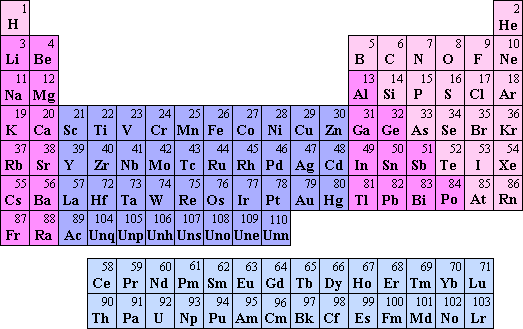 Glucose (shown below) is an organic substance because it has carbon atoms bonded to other carbon atoms which can be broken apart to release energy. 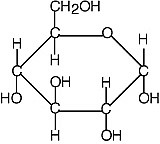 A MOLECULE OF GLUCOSE Is C02 an organic substance? Use the definition above (definition of an organic nutrient) to answer this. [C02
(carbon dioxide) is a combination of one atom of carbon bonded
to 2
atoms of oxygen.]
Click here if you think C02 is an organic substance. Click here if you think C02 is NOT an organic substance. Why or why not? You should be able to answer this now. Send me a message if you're still confused. Four of the 6 categories (the ones in a green font) of nutrients are organic. 1.
carbohydrates
(sugar, starch, fiber)
2. fats 3. proteins 4. water 5. vitamins 6. minerals The vitamins in our food ARE organic and contain energy. Why can't our bodies release this energy that is in vitamins? One reason we can NOT release the energy in vitamins is that we don't want to! Releasing the energy in vitamins would require breaking the vitamins apart. Then we would not have vitamins available to do for us what we need them to do, such as help us heal (vitamin C) or see (vitamin A). So we don't make the enzymes needed to break apart vitamins. 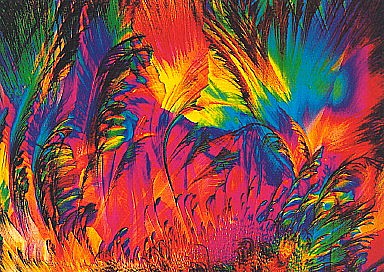 Photomicrograph of Vitamin C by Michael W. Davidson, 1990 Center for Materials Research & Technology and Institute of Molecular Biophysics The Florida State University, Tallahassee |
|||
|
G. Definition of an inorganic nutrient- A nutrient without a carbon to carbon bond and it cannot be broken apart to release energy. Inorganic nutrients are not created, nor are they destroyed. Which of the 6
categories of nutrients are inorganic? Water
and minerals. These are inorganic nutrients
that plants get from the soil to grow and thrive
(they can't synthesize them since they are
inorganic). The other nutrients
(carbohydrates, proteins, fats, and vitamins)
plants can synthesize since they are organic.
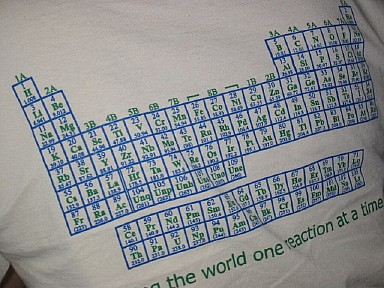 Above is another look at the Periodic Table of the Elements. 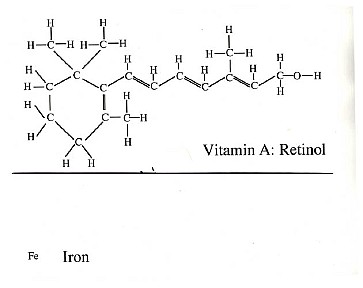 Your Turkey Cheese Frank fell into the barbecue and is now nothing but ash. Which of the six categories of nutrients is this ash composed of? The ash is composed of minerals. What did the carbohydrates, proteins, fats & vitamins become? All of these are organic and they burned up and became:
1. heat
2. carbon dioxide (which went into the air) 3. water (which evaporated) H. Definition of a Calorie (kcal)- used to measure the energy in foods. The text states that is a unit of heat also a unit of energy and is a measure of how much energy (or potential heat) is in a food
|
|||
 This 1912 cookbook
is by Fannie Merritt Farmer. Notice
below how food was classified.
 Which of the 6
categories of nutrients was missing back in 1912?
|
|
II Placebo Effect
(Definition of
placebo- NOT a real treatment but it might induce
body's natural
healing process from the ACT of treatment, not a
treatment itself.) Consider the following: 500 women were divided into 2 groups. One group took 1200 mg of calcium a day and the other took a placebo. After 3 menstrual cycles, the calcium group reported a nearly 50 percent drop in 4 major PMS symptoms: mood swings, pain, water retention and food cravings. The placebo group saw a 30% decrease (Newsweek, Special Issue) Why is this an example of the placebo effect? It is an example of
the placebo effect because BOTH groups saw
improvement, even the group receiving the placebo.
For the next section, read the following article. It will help you fill in some blanks in your Lecture Outline. Brody, H. (2000, August). Tapping the Power of the Placebo. Newsweek. Retrieved from http://www.uri-geller.com/placebo_article.htm |
What is the definition of a "quack remedy"?
A placebo effect is
not exaggerated, deceptive, money-making or harmful,
but the benefits ARE likely temporary.
It is something that is documented during
research to determine
if a treatment is more effective than a placebo
treatment.
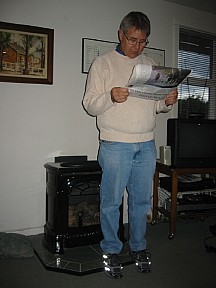 Here is Beth's
husband warming up
in front of her gas stove and he thinks he IS
warming up. But you'll
notice that he is receiving a placebo
benefit because the stove is NOT ON.
Just standing there induced his body to do activities that made him feel warm, like increasing circulation. But it's definitely temporary. This is the end of Lecture 1A. Also watch Lecture 1B during week 1. |
Incorrect. Carbon dioxide has just one carbon atom, so it is NOT considered organic. An organic nutrient (or an organic substance) contains carbon atoms bonded to carbon atoms which can be broken apart (also called burned) to release energy.
